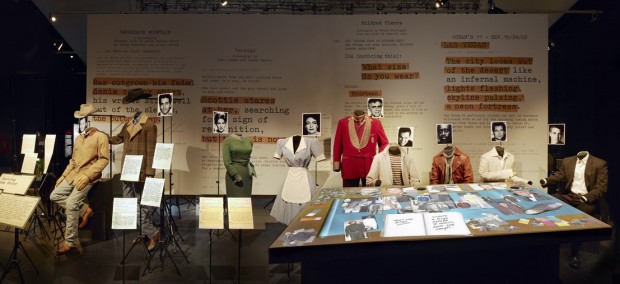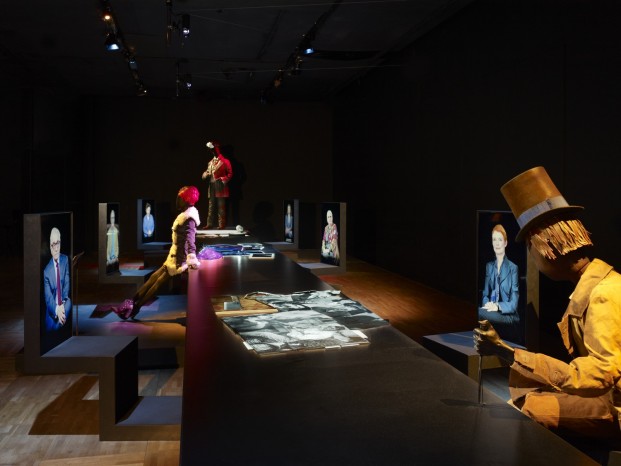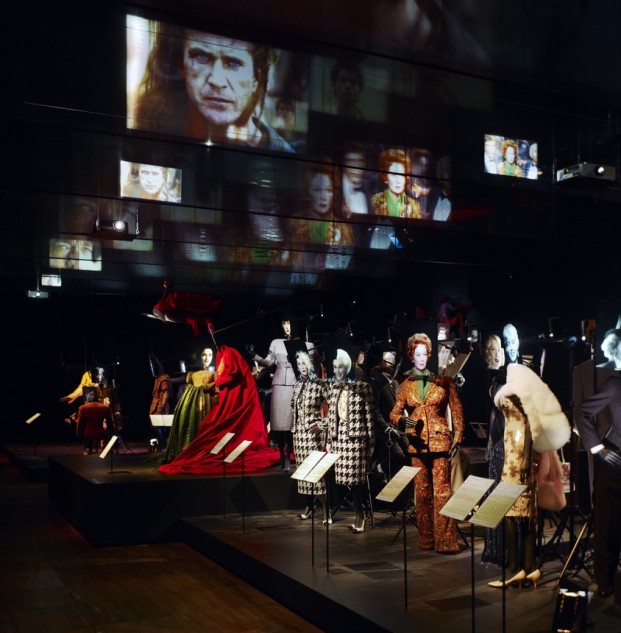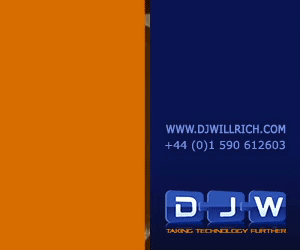A thoughtfully constructed journey through the costume design process from script to post production, the show features over 120 costumes from a century of Hollywood cinema.
As it continues to attract record numbers of visitors to the V&A, we go behind the scenes to speak with Roger Mann and Gary Shelley of exhibition design practice Casson Mann and guest curator Deborah Nadoolman Landis, and ask how it all came together.
Creating a spatial experience
RM – Stories and films are wonderful; you have an audience completely captivated by the artistry of the film. But as museum and exhibition designers the challenge was to turn the cinema into a spatial and emotive experience.
GS – We wanted to create a soundstage environment that would help to distance the visitor from the conventional expectations of being in the V&A’s temporary galleries. So all three galleries are completely matt black with tripod lighting and cable runs – reinforcing that this exhibition is not about cinema but about creative process.

Bringing costumes to life
GS – The real challenge was that this exhibition is all about the creation of iconic characters that we know and love. But the costumes in themselves aren’t that interesting. They’re almost like a snake when it sheds its skin – no longer alive.
RM – And because costumes are really nothing special on their own, not designed to be seen outside the movie context or in three dimensions, we knew we had to be that much more playful, that much more magical with them, much more engaging, we had to help them come alive.
DNL – So my BIG questions were always: How do we bring these costumes to life outside of the movie context they were created for? How do we avoid showing dresses on dummies? How do show working garments not glamorous couture?
GS – We experimented with how to best bring the costumes to life so that visitors would instantly connect with the character and film. We realised that without faces the costumes, even famous ones, were difficult to recognise.
A lot of R&D went into getting a serious likeness that did justice to the movie and justice to the acting. We finally opted for close-up film clips projected on to tiny screens above the shoulders of each costume. So each face is a little movie with the motivation of the character passing across it. The effect is a room full of characters that the visitor can instantly recognise and connect with.

Designing the experience
DNL – The three galleries follow the costume designer’s creative process – Act I: De-construction in which we are introduced to the role of costume designer and learn the craft, continues to Act II: Dialogue in which we discover creative collaborations and eavesdrop on real conversations between directors, costume designers and actors and ends in Act III: The Finale, is a massive celebration of the best known characters of Hollywood film history.
Act I: De-construction
GS – Our starting point was to ask ourselves ‘if you’ve got Indiana Jones’ how do you communicate what he’s about and we set about ‘de-constructing him on every level – what is he wearing, why is he wearing it, what that identifies about his character, and putting the costume in a recognisable pose that the audience recognises and connects with.
RM – We look at the various aspects of how these costumes come about and begin weaving the story of how the process works, where characters come from, how they take form from script to a believable person. We use music and lighting to create a sense of drama and projected film clips, sketches and anecdotal stories provide the back-story and an emotional connection.

Act II: Dialogue
DNL – The challenge for Casson Mann was how to show work in process in this gallery: how do we bring to the public what really happens when a costume designer and a director sit down; what do they talk about and how do we make this conversation come alive; how do we see the research and how do we realise this for our visitor.
RM – We wanted the visitor to feel they are really part of the conversations that happen between designers, directors, actors and actresses. So we stage workshop environments with specially commissioned interviews and projected tables showing sketches, swatches, photos, notes, script and annotated scripts as they are being talked about.

GS – We’re creating the ‘behind the scenes’ view, giving the visitor a sense of privileged access to the stars of the screen that are in the same gallery with them.
Act III: Finale
RM – We finish the exhibition with a wonderful celebration of film and film characters, completing the journey for the audience. So we thought about how to fill the space with a sense of cinematic moments, and pose costumes in such a way that they would feel true to their character. From pitch to completion, this idea of using translucent materials and projections to fill the volume of space with the magic and emotion of cinema has stayed the same.

GS – We ended up in the studio posing in scale more or less every character in the show, and then their relationship to other characters. It became a fun thing for us, this juxtaposition between characters and we invented groups of that really work together as a theme of the exhibition.
We choreographed it through days and days of playing with toys, barbies and wooden figures using elastic bands, bulldog clips and bits of faces and we built a scale replica of the gallery out in the front of our studio and we started to position these characters to interact.
DNL – I had high aspirations for the design of this show, and the challenge for me was to find a design company that I could trust to tell this story and recreate the excitement and the feeling of being in a film for the audience, at the V&A. Casson Mann clinched that vision and it’s an enormously entertaining and engaging exhibition.
Back to top




